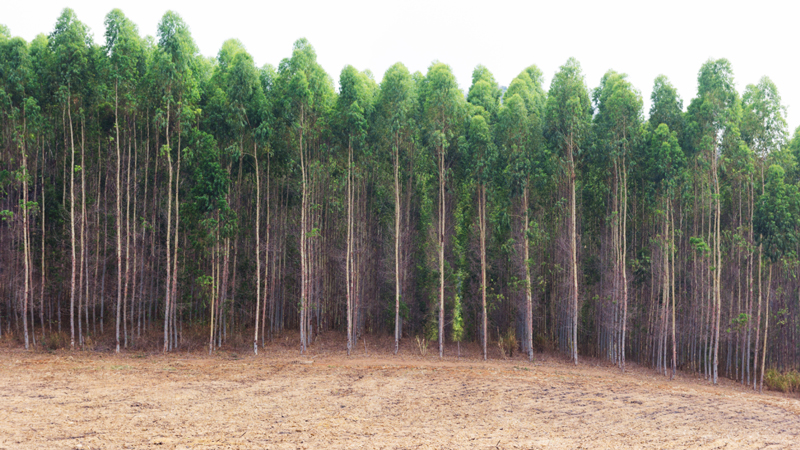We Can’t See the Forest for the Trees
The Challenge of Reforesting Our World
Can planting trees help us avert what scientists describe as an impending climate-driven disaster?
“From Greta Thunberg to Donald Trump and airlines to oil companies, everyone is suddenly going crazy for trees,” writes BBC science editor David Shukman. It’s undeniable: trees and forests have become a hot topic. They’ve ignited burning questions, sparked a fiery debate, and lit the fuse to what could be an explosive change in our relationship with nature.
To understand why, we have to investigate the past, like counting the rings on a fallen tree. A 1994 study distilled our history with trees. In essence, it concluded, humans overexploit forests until the forests are so degraded that it negatively impacts humans. A culture change often follows, which can lead to varying degrees of forest recovery. Unless lessons are learned, however, the cycle is then set to begin again.
As we have previously noted in Vision, we humans lack an adequate understanding of our relationship with nature. Generally, being environmentally friendly is a secondary priority and only becomes primary when overexploitation begins to negatively impact our own lives. Decades of deforestation and forest degradation are now doing just that.
A 2021 study demonstrated that southeast Amazonia, part of a landscape containing half of the planet’s remaining tropical forests, is now a carbon source rather than a carbon sink. This is far from normal. Ordinarily, forests are carbon sinks because trees remove and store carbon from the atmosphere through photosynthesis. But a recent UNESCO survey of 257 forests in World Heritage sites found that factors such as fires, clearing for agriculture, and even hurricanes have turned 10 of those forests into carbon sources.
Because carbon, in the form of carbon dioxide in the atmosphere, already contributes significantly to climate change through the greenhouse effect, the need to keep the average global temperature to no more than 1.5°C above preindustrial levels is growing urgent. When forests start emitting more carbon than they absorb, it throws this target into serious jeopardy.
The consequences of climate change are complex, to say the least, but on the whole they’re negative for everyone and everything. We’re at a point in the cycle where a culture change is needed. And one idea that’s gaining traction is reforesting (in fact, it was a talking point at the COP26 climate-change conference in November 2021). Can it work?
Turning Over a New Leaf
To bring about the needed change, it might seem reasonable to adopt a simple and clear slogan: “Plant more trees; slow down climate change.” In fact, that’s essentially the message that has roused many people from all walks of life to join the war against climate change.
The UK government, for example, has committed to planting 30,000 hectares of trees per year and to spending over £500 million on trees and woodlands in England by 2025 (1 hectare is about 2.5 acres; 30,000 is about 116 square miles). YouTube broadcaster Jimmy Donaldson, whose online alias is MrBeast, launched a campaign to raise $20 million for planting 20 million trees. A US proposal, the Trillion Trees Act, aims at planting a trillion trees globally as “a pragmatic step towards addressing global carbon emissions.”
It must be a good thing that so many are suddenly going crazy for trees, right? Actually, most of those advocating tree-planting are quick to acknowledge that halting or even slowing climate change requires much more.
But slogans and pithy messages do motivate people. Fred Shapiro, editor of the Yale Book of Quotations, observes that the very reason slogans, quotations, catchphrases, mantras and proverbs are so popular and powerful is that they connect people to each other and to the wisdom of the past. He indicates, however, that their very simplicity can create not only simplicity of thought but groupthink; adherents rule out complex ideas and don’t reflect on what they’re doing. As one ancient proverb warns, zeal without knowledge is dangerous.
“There is an idea that you can just buy land and plant trees but that’s too simplistic—there is a risk of doing more harm than good.”
The Root of the Problem
Is planting millions of trees feasible? Perhaps more importantly, is it worthwhile?
A 2019 study showed that globally, the earth could support an additional 900 million hectares (nearly 3.5 million square miles) of canopy cover, which could store 205 gigatonnes of carbon—equivalent to several years’ worth of the world’s current emissions. So yes, theoretically at least, planting more trees is possible and could make a significant difference in the war against climate change.
But how, in practical terms, do we restore trees and forests?
The popularized methods generally fall into two camps: those with human management and those without. By examining these contrasting approaches, investigating examples of each and exploring their pros and cons, we can better understand Shapiro’s warning about simplicity of thought, and why the proverb about zeal without knowledge is so relevant.
In the first camp are those who promote the most obvious approach: planting new trees.
Plant-for-the-Planet, for instance, focuses on restoring forests, primarily in tropical regions. Founder Felix Finkbeiner noted that, as an example, they’re “restoring 20,000 hectares . . . of degraded rainforest in Mexico’s Yucatán Peninsula.” They have “100 people there planting, on average, one tree every 15 seconds” and have “planted 5 million trees since 2015.” In the context of slowing down climate change, each tree can be expected to remove and store 200 kilograms of carbon over its lifespan, or the amount generated, on average, by a car being driven 800 kilometers (500 miles).
Another movement, known as the Bonn Challenge, currently involves 61 countries. It began in 2011 as “a global goal to bring 150 million hectares of degraded and deforested landscapes into restoration by 2020 and 350 million hectares by 2030.” The amount of carbon that could be removed and stored if such a goal were achieved would be phenomenal.
This is where “Plant more trees; slow down climate change” becomes more nuanced, however.
Tree plantations are the most popular restoration plan in the Bonn Challenge, but 45 percent of all commitments involve monoculture—planting a single tree species as a profit-making enterprise, a cash crop. “After they are harvested and the land is cleared for replanting—typically once a decade,” says a 2019 article in Nature, “—the carbon is released again by the decomposition of plantation waste and products (mostly paper and woodchip boards).” And the very process of clearing a forest releases additional atmospheric carbon. The net positive effect on carbon capture is therefore negligible at best.
“Plantations are important economically, but they should not be classified as forest restoration. That definition urgently needs an overhaul to exclude monoculture plantations.”
What’s worse than no net impact from planting new trees is, of course, a net negative impact. In fact, the push to plant trees has been so extreme that in some cases it has had negative environmental impacts. In Chile, subsidies for tree planting created a perverse incentive to plant trees instead of conserving existing natural forests. Between 1986 and 2011, the policy triggered a loss of natural forest cover and no net removal and storage of carbon.

A monoculture plantation of eucalyptus trees in Thailand awaits harvesting.
It seems clear that when governments, corporations and even nonprofit organizations pledge to plant more trees, they often overlook the bigger picture.
Thomas Crowther, coauthor of “The Global Tree Restoration Potential” (Science, July 2019), told The Guardian: “I’ve never in my life said we should plant a trillion trees. It gives the impression of plantations everywhere. . . . The idea of planting individual trees isolates them from the microbes in the soil, the birds, the animals and the other plants that are necessary.” The opportunity to consult those with knowledge is there if we aren’t blinded by our zeal.
This leads us to the second fundamental approach to reforestation, which is the least reliant on human management: natural regeneration.
Natural regeneration, or passive rewilding, means leaving the land to restore itself through the process of succession: pioneer species, adapted to survive in poor conditions, rapidly colonize the land, their seeds being either dormant in the soil or dispersed from surrounding habitats. As these species colonize the land, they change the habitat. These changes allow other species, better suited to the changed habitat, to out-compete the pioneer species. The process continues until a stable community becomes established, dominated by a small number of prominent species. This state of equilibrium is called a climax community. The result is a forest that is well adapted to local conditions.
A 2021 UK study showed the feasibility of allowing abandoned farmland situated near existing woodland to passively rewild. Additionally, the previously mentioned 2019 article in Nature showed that natural forests are about “40 times better than plantations at storing carbon.”
“Our study provides direct empirical evidence that passive rewilding has the potential to expand native woodland habitat at very low cost and within relatively short timescales.”
Theoretically, then, natural regeneration is the better option for slowing down climate change. Does it work in practice?
Around 1961 Kenneth Mellanby, director of a research center in Cambridgeshire, England, typed a note describing a four-hectare arable field that lay next to an ancient woodland. The note read, “It might be interesting to watch what happens to this area if man does not interfere. Will it become a wood again, how long will it take, which species will be in it?” They harvested that year’s barley crop before ploughing the field and abandoning it. After 59 years, the field had become a closed canopy forest with almost 400 trees per hectare. As hoped, it was a structurally complex forest similar to neighboring ancient woodlands.
Zeal for such rewilding is growing, with the movement fronted by renowned environmentalists such as George Monbiot, and is attracting people from all walks of life. In fact, British environmentalist Chris Packham recently delivered a petition to Buckingham Palace, calling on the British Royal Family to rewild their estates. The petition was signed by 100,000 people, including former Archbishop of Canterbury Rowan Williams.
It seems reasonable to think that environmentalists understand the issues and must therefore know what they’re doing. Undoubtedly, they are the experts when it comes to the environmental factors of any debate. But when socioeconomic and political factors are taken into consideration, we see that neither planting trees nor rewilding is truly viable on its own. Each approach is simplistic and leads to groupthink. And each highlights the need to consider the bigger picture and the wider impacts.
Stumped
The culture change whereby everyone is suddenly going crazy for trees is, in principle, a good thing. Recognizing that our tendency is to exploit natural capital, and desiring to move toward a right relationship with the environment, is, in principle, a good thing. However, good intentions can also be exploited.
As already mentioned, plantations for profit are the most popular restoration plan among nations participating in the Bonn Challenge. This makes the priority of those particular governments obvious. In other cases, priorities aren’t as clear.
One example is the United Nations’ REDD+ scheme. REDD stands for Reducing Emissions from Deforestation and forest Degradation; the “+” signifies the role of conservation, sustainable management of forests, and enhancement of forest carbon stocks. Countries are paid to preserve their forests in exchange for carbon credits, which they can then sell in order to help offset another country’s emissions. By buying carbon credits rather than accepting their social responsibility to actively reduce emissions, governments and corporations call into question their good intentions.
Being environmentally friendly is typically a lower priority than profits, in part because the value of natural capital can be difficult to quantify. There is therefore little incentive to fix problems at the source. But the general public is putting increasing pressure on governments and corporations to be more environmentally friendly, as borne out by the 100,000 people who marched in Glasgow during the COP26 summit.
Simply pledging to plant trees rather than address the problem holistically is an example of greenwashing—an approach designed to save face rather than save forests, and ideally to increase profits in the process.
“If companies are serious about planting trees then they need to care about the communities that live with them and not just their own reputations.”
Even natural regeneration, or passive rewilding, raises socioeconomic and political issues. To some, it sounds like paying farmers to stop doing what they’re meant to do, with national food dependency seen as the inevitable result. The rewilding approach may therefore hold little appeal as an investment strategy. Still, governments and corporations are making ambitious promises to reduce carbon emissions, whether genuinely or in an attempt at greenwashing.
But what happens when targets for such projects as tree planting and forest restoration aren’t met? Many people believe they’re in a battle to save the planet. Without a clear understanding of the whole picture, untempered zeal can backfire or even lead to extremism.

The Seeds of an Idea
Is there a way to restore forests that avoids the negative impact of monoculture, the economic uncertainty of leaving the land to naturally regenerate, and the social issues of greenwashing?
In his 2021 book, This Can’t Be Happening, George Monbiot writes, “I will work to recover the knowledge I have lost. For I now see that without the power of memory, we cannot hope to defend the world we love.” He implies that at least some of the solutions to our environmental issues may be found in our history.
We’ve already looked at the past to understand why so many are suddenly going crazy for trees. Can we also look to the past as we consider how best to restore our forests?
In the United Kingdom, the oldest forests have been managed using a traditional technique called coppicing, which relies on the capacity of many tree species to put out new shoots from their stump and roots if cut down. A tree with a single stem is felled in winter, and the tree responds the following spring by putting out multiple new stems. After a number of years, these are harvested and the cycle begins anew. “It is one of the most perfectly sustainable resources and ecosystems known to man,” claims British horticulturist Monty Don. As areas are cleared, the forest becomes a patchwork of different stages of regrowth, creating a structurally complex woodland. It’s not just the environment that benefits; the system yields social and economic benefits too, since managing the forest creates jobs, and the harvested timber can be sold.
So one solution is to restore traditional management techniques for tending and keeping our existing natural forests using some of the oldest principles known to humankind. This challenges the belief that all human activity is detrimental to the environment. In fact, says Monty Don, “the image of idealised woodland as a static, stately place, fixed by ranks of mature trees is completely modern and only the result of neglect.” Without human management, the coppice system collapses. The crucial factor? We need knowledge from our history to guide our zeal for restoring these sustainable resources and ecosystems.
“If woodland is not regularly worked then it tends to disappear—just as most of it has done in the past 50 years. To grub up coppice woodland and replace it with a plantation of spruce larches is to destroy it as effectively as covering it with concrete.”
Scientists agree that maintaining existing natural forests isn’t enough to slow down climate change. More trees and more forests are needed. But as we’ve discussed, monoculture isn’t the answer; and it’s difficult to quantify the value of natural regeneration or rewilding, leading some to argue that the land could be better used for growing food instead of trees.
But land use needn’t be a binary choice. Agroforestry is another land management approach; it combines trees and shrubs with crops and livestock, avoiding the potential trade-off between profit and carbon abatement. A study of 286 agroforestry systems covering 37 million hectares across 57 countries found that crop yields increased by 79 percent on average. Furthermore, a study by the European Agroforestry Federation concluded that with 50 to 100 trees per hectare of agricultural land, 1 to 4 tonnes of carbon is removed and stored per year per hectare. To put this in perspective, the average person in the United Kingdom generates 5.5 tonnes of carbon dioxide emissions per year.
Heartwood
Planting trees is a good thing. But our approach has largely been one of extremes—driven by simplistic catchphrases and often-polarized groupthink. The human tendency is to reject other perspectives, believing that we alone are right.
It’s also true, however, that pithy catchphrases can connect people to other people and to the wisdom of the past. So perhaps the solution lies in a balanced approach that involves people and ancient wisdom as much as it involves trees.
Such an approach might include teaching people to harvest timber sustainably from existing coppice woodlands instead of unsustainably from new plantations. Or teaching people to blur the lines between the natural environment and the man-made environment, beginning with agriculture, rather than dividing it artificially into monoculture and reserve.
We’re clearly not going to stop agriculture, forestry and fishing, because we derive a lot of benefits from them. But we are in need of an approach that has been thought through so that everyone and everything will benefit now and in the future—a gentler approach, founded on love for our neighbor and concern for the environment that sustains us all.


